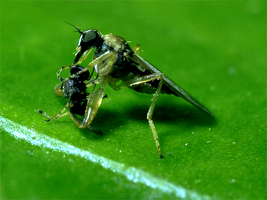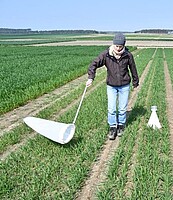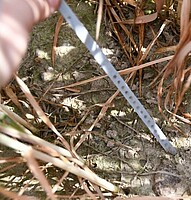CP11: Prey-predator-Interactions in NOcsPS winter wheat cropping systemsepartment of Phytopathology
Predatory flies of the genus Platypalpus (Hypotidae, Empidoidea) are natural enemies of herbivorous flies and midges in winter wheat cropping systems and thus important elements of natural regulation in agricultural systems (Stark & Wetzel 1987, Weber et al. 1997).
The use of synthetic pesticides is able to cause direct and indirect effects such as the limitation of prey or habitat changes. Therefore, populations are deeply exposed to disturbances such as the use of non-selective insecticides and not able to recover through immigration as fast as other predator groups.
The aim of this work package is to prove if avoidance of synthetic pesticides is able to stabilize or even increase prey-predator-interactions in the long term and to investigate additional effects induced by the fertilization strategy and the plant stand formation (e.g. equidistant row spacing).
The following hypotheses shall be proved:
- The absence of synthetic pesticides in NOcsPS treatments leads to increased abundance of predatory flies and higher rates of natural regulation
- Organic fertilizers result in a more active soil life than mineral fertilisation and promote the abundance of predatory flies and the natural regulation
- The mechanical regulation of herbs in the NOcsPS treatments increases the compound of organic substance in the soil, which has positive effects on the abundance of predatory flies and the natural regulation
- Equidistant row spacing improves soil characteristics (e.g. structure, humus, pH-value) and affects the abundance of predatory flies and the natural regulation
The occurrence of predatory flies will be assessed in the different winter wheat plots using soil photoeclectors and standardized catches by using insect sweep nets from May until July. The soil photoeclectors a will serve to measure the hatching abundances and insect biomass (weight) during the experimental period. Weekly standardized catches by using insect sweep allow gaining comparative results on the activity dynamics of the predatory flies. Furthermore, weekly assessments of pests’ occurrence will be conducted at 25 single wheat plants. Additional bait stick feeding tests will be applied to determine the soil activity inside the plots.
The results of this project enable findings on the effects of NOcsPS as well as fertilizer strategies and stand formation (e.g. equidistant row spacing) on abundance, diversity and function of predatory flies and their prey organisms in wheat cropping systems.







